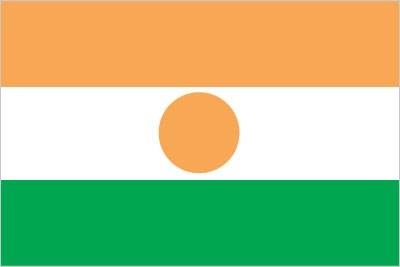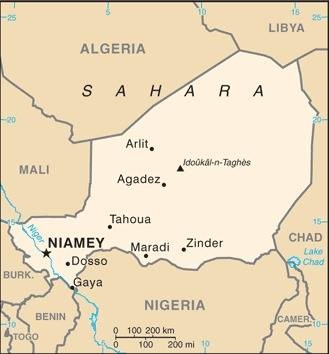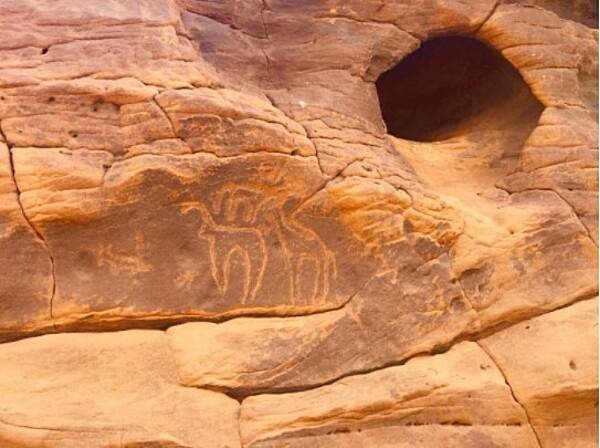214 Niger

Three equal horizontal bands of orange (top), white, and green with a small orange disk centered in the white band. The orange band denotes the drier northern regions of the Sahara. White stands for purity and innocence. Green symbolizes hope and the fertile and productive southern and western areas, as well as the Niger River. The orange disc represents the sun and the sacrifices made by the people.
Flag courtesy of the CIA World Factbook

Map courtesy of the CIA World Factbook

A petroglyph, or ancient rock carving, is usually associated with prehistoric times and considered to be among the first markers of human presence. These petroglyphs were found in Airlit, of the Agadez Region in northern-central Niger, between the Sahara Desert and the eastern edge of the Aïr Mountains. The carvings show some of the local fauna including giraffes.
Photo courtesy of the CIA World Factbook
Government
According to Britannica, under the constitution of 2010, Niger is a republic. The president, who serves as head of state, is elected to a five-year term by popular vote, with a limit of two terms. The president appoints the prime minister, who serves as the head of government. Legislative power is vested in the unicameral National Assembly; members are popularly elected and serve five-year terms. Niger’s judicial system comprises the High Court of Justice, the Supreme Court, the Constitutional Court, and the Courts of First Instance.
For administrative purposes, Niger is divided into one capital district, Niamey, and seven régions (regions), Agadez, Diffa, Dosso, Maradi, Tahoua, Tillaberi, and Zinder, each of which is administered by a prefect. Each region is further divided into several districts, with each district led by a subprefect.
National Civil Aviation Agency (ANAC)
National Civil Aviation Agency (ANAC) is the civil aviation authority serving the safety and development of air transport in Niger.
Airspace
SkyVector – Google Maps – ADS-B Exchange
ICAO countries publish an Aeronautical Information Publication (AIP). This document is divided into three parts: General (GEN), En Route (ENR) and Aerodromes (AD). ENR 1.4 details the types of airspace classes they chose to adopt from classes A through G.
Drone Regulations
Drone Registration (Recording)
Advanced Air Mobility (AAM) Regulations & Policies
None found by the author.
However, should you, the reader, happen to stumble across something to the contrary, please email the author at FISHE5CA@erau.edu and you may be mentioned in the ACKNOWLEDGEMENTS section of this book by way of thanks for contributing to this free eBook!
Advanced Air Mobility (AAM) News
None found by the author.
However, should you, the reader, happen to stumble across something to the contrary, please email the author at FISHE5CA@erau.edu and you may be mentioned in the ACKNOWLEDGEMENTS section of this book by way of thanks for contributing to this free eBook!
Short Essay Questions
Scenario-Based Question
You have been hired by a Drone Startup Company. Your boss has immediately assigned this job to you.
They need you to prepare a one-page memo detailing the legalities of using a drone to look for petroglyphs over Airlit.
They need you to mention any national laws and local ordinances.
They specifically want to know what airspace (insert pictures) you will be operating in and whether or not you need an airspace authorization.
Does it matter whether or not you are a citizen of the country?
Lastly, there is a bonus for you if, as you scroll through this chapter, you find any typos or broken links!
Short Essay Questions
- What are the drone categories?
- How is registration addressed?
- How is remote ID addressed?
- What are the model aircraft rules?
- What are the commercial drone rules?
- Are there waivers or exemptions to the rules? If so, for what?
- Would you share a link to an interactive airspace map?
- How is BVLOS addressed?
- How can you fly drones at night?
- How can you fly drones over people?
- Where do you find drone NOTAMs?
- What are the rules for drone maintenance?
- What are the rules for an SMS program?
- What are some unique rules not mentioned above?
- What are the C-UAS rules?
- What are the AAM rules?

